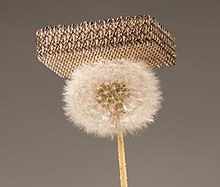
A metallic microlattice is a synthetic porous metallic material consisting of an ultra-light metal foam. With a density as low as 0.99 mg/cm3 (0.00561 lb/ft3), it is one of the lightest structural materials known to science.[1] It was developed by a team of scientists from California-based HRL Laboratories, in collaboration with researchers at University of California, Irvine and Caltech, and was first announced in November 2011. The prototype samples were made from a nickel-phosphorus alloy.[2] In 2012, the microlattice prototype was declared one of 10 World-Changing Innovations by Popular Mechanics.[3] Metallic microlattice technology has numerous potential applications in automotive and aeronautical engineering.[4] A detailed comparative review study among other types of metallic lattice structures showed them to be beneficial for light-weighting purposes but expensive to manufacture.[5]
- ^ Cite error: The named reference
ChineseAerogelwas invoked but never defined (see the help page). - ^ Cite error: The named reference
cwwas invoked but never defined (see the help page). - ^ Sterling, Robert (29 October 2012). "The world's lightest material". Boeing. Archived from the original on 2 November 2012. Retrieved 2 November 2012.
- ^ Cite error: The named reference
RevoBenefitwas invoked but never defined (see the help page). - ^ Cite error: The named reference
j4was invoked but never defined (see the help page).